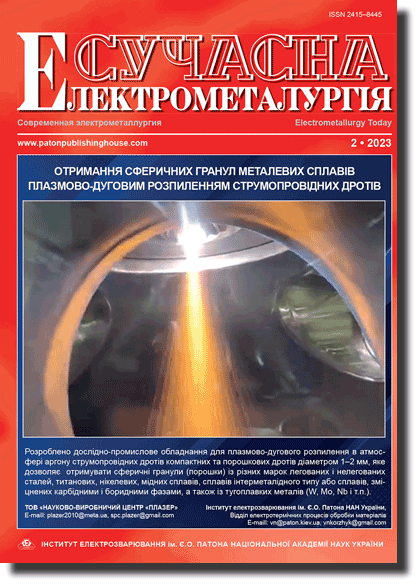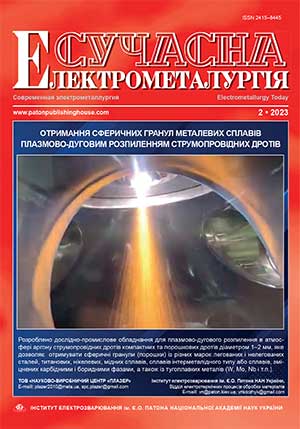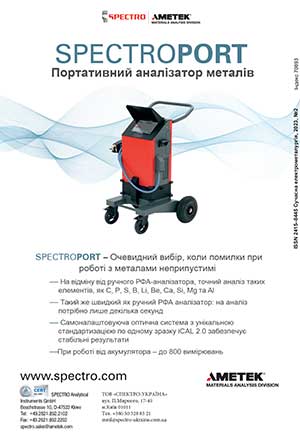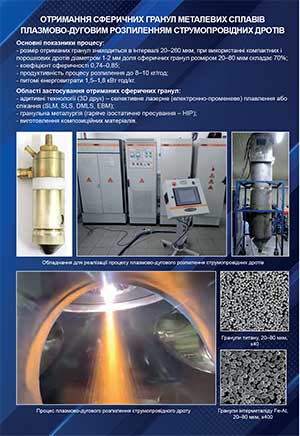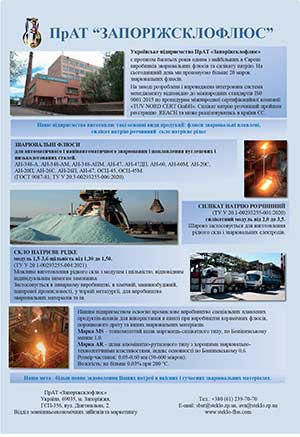| 2023 №02 (01) |
DOI of Article 10.37434/sem2023.02.02 |
2023 №02 (03) |
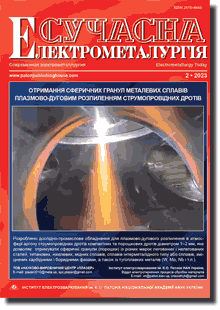
"Suchasna Elektrometallurgiya" (Electrometallurgy Today), 2023, #2, 14-22 pages
Electron beam technology of producing nanostructured silver coatings, and antimicrobial activity of pharmaceutical forms of nanocomposites
G.G. Didikin
E.O. Paton Electric Welding Institute of the NAS of Ukraine. 11 Kazymyr Malevych Str., 03150, Kyiv, Ukraine. E-mail: office@paton.kiev.uaAbstract
A technological scheme of the process of electron beam evaporation and condensation for synthesis of PVP–Ag nanocomposites is considered. The influence of output mass of silver, beam current, time and rate of silver evaporation on the size of silver nanoparticles is evaluated. The TEM method and photon-correlation spectroscopy were used to study the structure of PVP-Ag composite and PVP–Ag–H2O and PVP–Ag–alcohol colloid systems. Methodological and experimental developments of medicinal substances with antimicrobial activity based on Ag nanoparticles are considered. The studied substances were glucosamine with nanosilver, PVP with nanosilver and low-toxic gels with silver nanoparticles. A test sample with a pronounced bactericidal action against gram-positive (S.aureus) and gram-negative (Р.аеruginosa) microorganisms was studied. 21 Ref., 5 Tables, 7 Figures.
Keywords: electron beam evaporation and condensation (EB-PVD), nanoparticles, silver, colloid systems, gels with silver nanoparticles, bactericidal activity, drugs
Received 03.10.2022
References
1. Yanov, Yu.K. (1997) Actual problems of epidemiology and prophylaxis of postoperative infections. Vestnik Khirurgii I.I. Grekova, 156(3),106-109 [in Russian].2. Borysevych, V.B., Borysevych, B.V., Kaplunenko, V.G. (2009) Nanotechnology in veterinary medicine (Implementation of innovative technologies). Kyiv, TOV Nanomaterialy i Nanotekhnologii [in Ukrainian].
3. Sergeev, G.B. (2007) Nanochemistry. 2nd Ed. Moscow, MGU [in Russian].
4. Chekman, I.S., Serdyuk, A.M., Kundiev, Yu.I., Trakhtenberg, I.M. (2009) Nanotoxicology: Directions of investigations. Dovkillya ta Zdoroviya, 7, 3-7 [in Ukrainian].
5. Sergeev, G.B. (2009) Nanochemistry: Manual. 3rd Ed. Moscow, KDU [in Russian].
6. Nam, K.T., Lee, Y.J., Krauland, E.M. et al. (2008) Peptide-mediated reduction of silver ions on engineered biological scaffolds. ACS Nano, 2(7), 1480-1486. https://doi.org/10.1021/nn800018n
7. Velusamy, P., Das, J., Pachaiappan, R. et al. (2015) Greener approach for synthesis of antibacterial silver nanoparticles using aqueous solution of neem gum (Azadirachta indica L.). Industrial Crops and Products, 66(1), 103-109. https://doi.org/10.1016/j.indcrop.2014.12.042
8. Nanda, A., Saravanan, М. (2009) Biosynthesis of silver nanoparticles from Staphylococcus aureus and its antimicrobial activity against MRSA and MRSE. Nanomedicine: NanoTechnology, Biology, and Medicine, l5(4), 452-456. https://doi.org/10.1016/j.nano.2009.01.012
9. Albrecht, M.A., Evans, C.W., Raston, C.L. (2006) Green chemistry and the health implications of nanoparticles. Green Chemistry, 18(5), 417-432. https://doi.org/10.1039/b517131h
10. Kaspar, Т.С., Droubay, Т., Chambers, S.A., Bagus, P.S. (2010) Spectroscopic evidence for Ag(III) in highly oxidized silver films by X-ray photoelectron spectroscopy. J. Phys. Chem., 114(49), 21562-21571. https://doi.org/10.1021/jp107914e
11. Bryzgunov, V.S., Lipin, V.N., Matrosova, V.R. (1964) Comparative evaluation of bacterial properties of silver water and antibiotics on pure culture microbes and their associations. Nauchn. Tr. Kazanskogo Med. In-ta, 14, 121-122 [in Russian].
12. Savadyan, E.Sh., Melnikova, V.M., Belikova, G.P. (1989) Modern tendencies of application of silver-containing antiseptics. Antibiotiki i Khimioterapiya, 11, 874-878 [in Russian].
13. Shahverdy, A.R., Fakhimi, Ali, Minaian, Sara (2007) Synthesis and effect of silver nanoparticles on the antibacterial activity of different antibiotic against staphylococcus and escherichiacoli. Nanomedicine-Nanotechnology Biology and Medicine, 3(2), 168-171. https://doi.org/10.1016/j.nano.2007.02.001
14. Ivanov, V.N., Larionov, G.M., Kulish, N.I. (1995) Some experimental and clinical results of application of silver cations againt drug-resistant microorganisms. Novosibirsk, SO RAMN, 53-62 [in Russian].
15. Alexander, J.W. (2009) History of the medical use of silver. Surgical Infections, 10(3), 289-292. https://doi.org/10.1089/sur.2008.9941
16. Shahverdy, A.R., Fakhimi, Ali, Minaian, Sara (2007) Synthesis and effect of silver nanoparticles on the antibacterial activity of different antibiotics against staphylococcus and escherichiacoli. Nanomedicine-Nanotechnology Biology and Medicine, 3(2), 168-171. https://doi.org/10.1016/j.nano.2007.02.001
17. Ershov, B.G. (2001) Nanoparticles of metals in aqueous solutions: Electron, optical and catalyst properties. J. of the D.I. Mendeleev Russian Chemical Society, 14(3), 20-30 [in Russian].
18. Christian, P., Kammer, V., Balousha, Р., Hofman, Th. (2008) Nanoparticles: Structure, properties, preparation and behavior in environmental media. Ecotoxicology, 17, 326-343. https://doi.org/10.1007/s10646-008-0213-1
19. Antomonov, M.Yu. (2006) Mathematical processing and analysis of biomedical data. Kyiv, FMD [in Russian].
20. Belova, O.V., Arion, V.Ya., Sergienko, V.I. (2008) Role of cytokines in immunological function of skin. Immunopatologiya, Alergologiya, Infektologiya, 1, 41-45 [in Russian].
21. Brun, L.V., Zuoanets, I.A., Isaev, S.G. (2002) Experimantal investigation of interaction of anti-inflammatory and reparative properties of N-phenylanthronilic acids and derivatives of glucosamine. Fiziologichno Aktyvni Rechovyny, 34(2), 65-69 [in Ukrainian].
Advertising in this issue:
The cost of subscription/purchase order journals or individual articles
| Journal/Currency | Annual Set | 1 issue printed |
1 issue |
one article |
| TPWJ/USD | 384 $ | 32 $ | 26 $ | 13 $ |
| TPWJ/EUR | 348 € | 29 € | 24 € | 12 € |
| TPWJ/UAH | 7200 UAH | 600 UAH | 600 UAH | 280 UAH |
| AS/UAH | 1800 UAH | 300 UAH | 300 UAH | 150 UAH |
| AS/USD | 192 $ | 32 $ | 26 $ | 13 $ |
| AS/EUR | 180 € | 30 € | 25 € | 12 € |
| SEM/UAH | 1200 UAH | 300 UAH | 300 UAH | 150 UAH |
| SEM/USD | 128 $ | 32 $ | 26 $ | 13 $ |
| SEM/EUR | 120 € | 30 € | 25 € | 12 € |
| TDNK/UAH | 1200 UAH | 300 UAH | 300 UAH | 150 UAH |
| TDNK/USD | 128 $ | 32 $ | 26 $ | 13 $ |
| TDNK/EUR | 120 € | 30 € | 25 € | 15 € |
AS = «Automatic Welding» - 6 issues per year;
TPWJ = «PATON WELDING JOURNAL» - 12 issues per year;
SEM = «Electrometallurgy Today» - 4 issues per year;
TDNK = «Technical Diagnostics and Non-Destructive Testing» - 4 issues per year.





